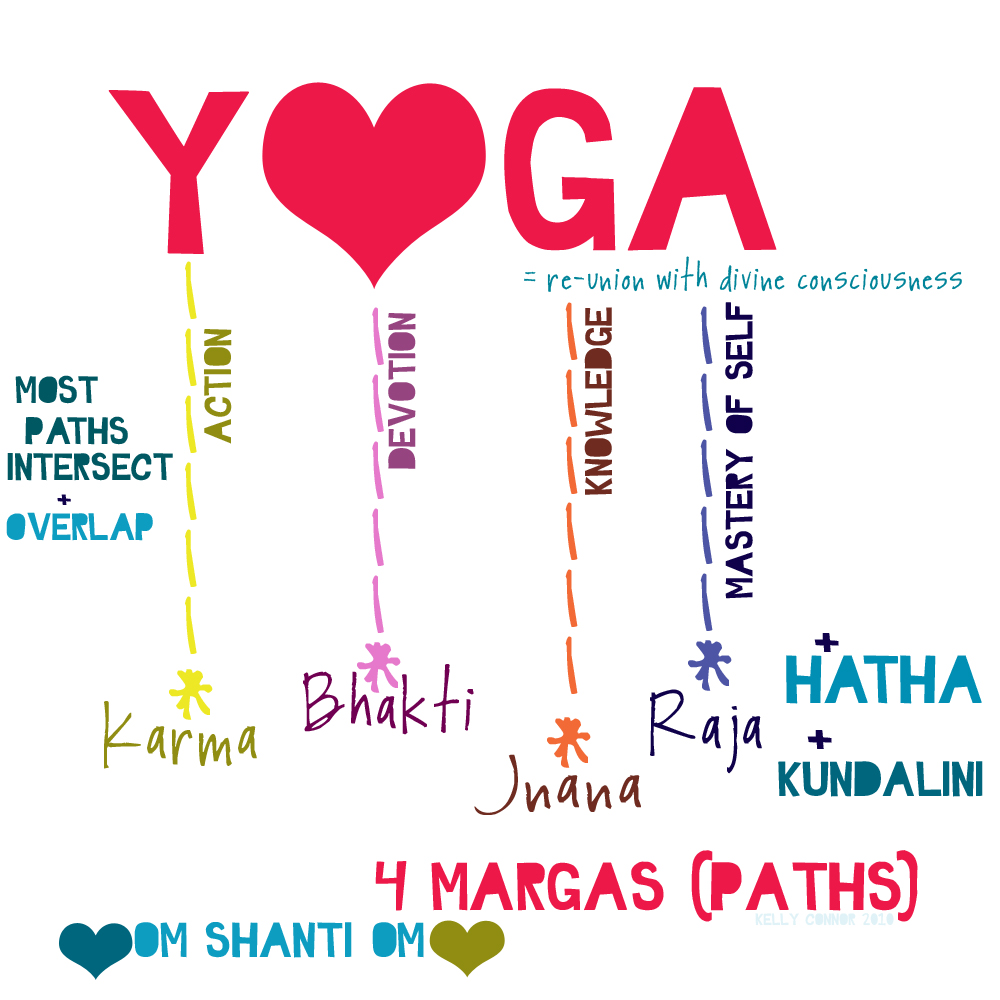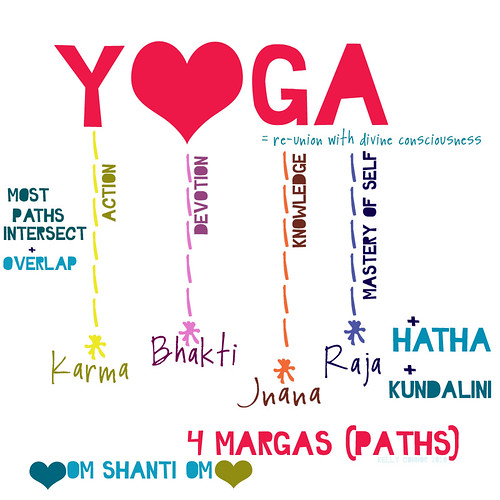As a follow-up to my review of Enlighten Up!, I’ve decided to discuss the major Margas or paths of yoga. You may recall a number of weeks ago when I spoke about whether yoga is religion in a video blog. During that discussion, I mentioned briefly the paths of yoga. I thought today might be the right time to go into more depth about the various routes yogis take to experience the Yoga (union, re-union with the divine). Guess what?! Some yogis have never downward dogged in their lives. “How can this be?” You might be asking yourself. Well, friends, yoga is union. Conscious union with the divine. And this union itself is devoid of belief. Yoga is based in experience, based in practice. How we practice achieving that divine union is really your call.
Margas
Now there are literally hundreds of paths, or Margas (laughter yoga and Nada Yoga-yoga of sound, are two examples), but the 4 primary paths or Margas are as follows: Raja, Karma, Bhakti, and Jnana. I made a little illustration to break them down visually.
In a nutshell, a yogi engages in his or her practice (Sadhana) on her path (Marga) to unite (or to open her eyes to the union that already exists if she happens to be a tantrika) with divine consciousness– to merge with God (substitute whatever word you prefer for God… it doesn’t matter what we call it).
- Karma Yoga: By engaging in selfless service, the practitioner achieves union.
- Bhakti Yoga: Through devotional practices, the practitioner achieves union.
- Jnana Yoga: Through the study of scriptures (though not by the attainment of knowledge alone), the practitioner achieves union.
- Raja Yoga: Through the practices described by Patanjali in the Yoga Sutras (Mastery of the Self), the practitioner achieves union.
If you’ve ever felt confused about yoga or about any of these margas, you are in good company; many of these terms have more than one meaning and significance in this tradition. For example, Karma is both a path of yoga (the path of action, selfless service) and the concept of cause-effect/ action-reaction/ samskara-kaivalya. Hatha yoga is another one that has numerous meanings and connotations depending on the context (over-simplifying here, but hatha generally is the physical practice of yoga, which can include asana-postures as well as pranayama-breathwork). Kundalini, too, has various meanings (Kundalini Yoga is a style of practice created by Yogi Bhajan , kundalini shakti is divine energy rising up the main energy channel {sushumna} in the spine, and kundalini meditations are practices to encourage kundalini rising…again… this is a major simplification… think of this as the view of yoga from 10,000 feet).
So really, honestly, we all have our own path. My path may not be right for all. What I try to present through my teaching and writing are practices that have had an effect in bringing Yoga-union into my life.
Now, tell me about your path.
ALL LOVE, Kelly.


TRICE = TRUTH’S RICE
ENLIGHTENMENT IN A TRICE
LEARN TO UNLEARN FOR SPACE
WORSHIP OF WORK FOR PACE
MIND TO NO MIND FOR SURFACE
YOU TO YOURSELF FOR ONE’S FACE
ONE TO KNOW ONE FOR GRACE
TOUCH ONE TO EVERYONE FOR SOLACE
SHOWER HAPPINESS FOR HUMAN RACE
SING NEW LIFE FOR LIFE’S ACE
LIVE NOW FOR GOD’S PLACE
Blessings, Ram0singhal.
Thank you for stopping by and for sharing your words.
Namaste.
I bow to god in you.
that is namaste (eastern greeting gesture )
left hand governed by right brain represents
soul.
right hand governed by left brain represents
body.
fold them together for prayer to experience
oneness that is present and taste of god.
and to be reality between dualities.
happiness is prayer and thanks to god